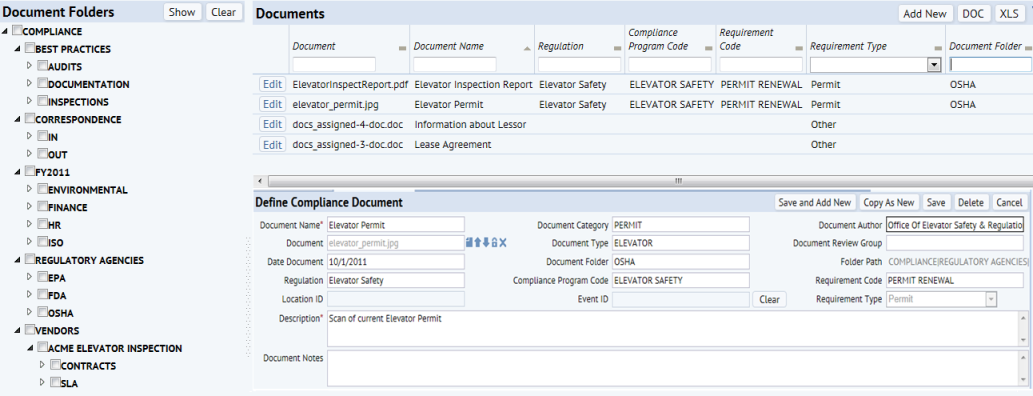Document Library: Overview
Developers and integrators can use the Document Library toolkit in their applications and extensions to add enhanced document organization and retrieval functionality. The toolkit makes it easier to organize a large volume of documents of many different types. In addition, you can associate multiple documents with a single source record, such as multiple documents per building, per compliance program, etc. You can have an unlimited number of documents associated with a single source record from any table.
The toolkit is built on top of the Document Management functionality, so the actual documents are still uploaded, stored, and downloaded with Web Central’s Document Management features.
Below is an example of the toolkit in use within a custom Compliance Management view:

Functionality
- Store unlimited number of documents per activity-specific parent table record
- Create virtual n-tier hierarchical folder structure, and place documents in folders for organization and search
- Create document categories and types and assign them to documents for organization and search
- Reusable common view for managing hierarchical document folder structure
- Reusable common view for managing Document Categories and Types
- Each activity provides custom views for adding documents and browsing/searching the document library
- Security available using a document review group setting for each document
Components
The Document Library module consists of the following:
- docfolder table – The n-tier hierarchical folder structure where you can “store” documents.
- doccat table – Assign these Document Categories to documents for filtering and search. A Document Category can have multiple child Document Types.
- doctype table – Assign these Document Types to documents for filtering and search. Document Types have a parent Document Category.
- docs_assigned table – This is the primary table for the Document Library toolkit. This is where you store documents and associate them with many attributes, such as folder, category, type, author, date, description, etc. You can also associate documents with the primary key of a table in your application.
ab-doc-def-folder.axvw view– This view manages the Document Folders (docfolder) table. It is generic and re-usable, so you should include it directly in your application, typically in a Business Process Owner (BPO) role. If you do need to write a custom view for managing Document Folders, it is critical to manage the docfolder.hierarchy_ids field correctly in order to maintain the integrity of the hierarchy. Use the code for this view as an example or build your custom view on top of this one.ab-doc-def-cat-type.axvw view– This view manages both the Document Categories (doccat) and Document Types (doctype) tables using a 2-level tree structure. It is generic and re-usable, so you should include it directly in your application, typically in a Business Process Owner (BPO) role
Procedure
Procedure for Adding a Document Library to an Application
Comparing the Document Library to Standard Document Management
- Continue to use Document Management field(s) in your tables if you need to store only a specific small number (e.g. <= 3) of documents per record, and you do not need to organize the documents by category, type, and/or folder.
- Use Document Library if you need any of the following features:
- Store many or unlimited number of documents per record
- Organize and filter documents by category, type, and/or folder
- Store general documents for activity without relating to a record
- Browse all documents for activity regardless of connection to any record in any table.